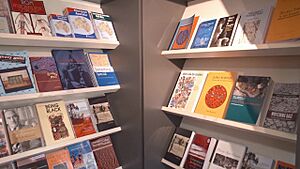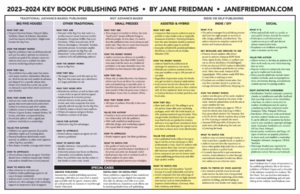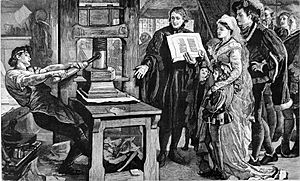Publishing facts for kids

Publishing is the process of sharing information, stories, music, and software with the public. Traditionally, publishing meant creating and selling printed works like books, newspapers, and magazines. Today, the definition has grown to include digital publishing. This includes e-books, websites, social media, and video games.
The publishing industry includes huge international companies, such as Penguin Random House and HarperCollins, as well as thousands of small independent publishers. Governments and schools also publish reports and textbooks. Recently, self-publishing has become very popular, allowing individuals to publish their own work without a large company.
Contents
Stages of Publishing
Creating a book or magazine involves many steps before it is ready for readers. While the process can vary, it usually includes:
- Commissioning (Hiring an author to write)
- Writing
- Copy editing (Checking for mistakes)
- Design (Creating the cover and layout)
- Typesetting (Arranging the text on the page)
- Proofreading (Final check for errors)
- Printing or Uploading
- Distribution (Sending to stores)
- Marketing (Advertising the work)
Types of Publishers
There are many different kinds of publishing depending on what is being created.
Newspaper Publishing
Newspapers and news websites report on current events. They are written by journalists. News helps people understand what is happening in their town and around the world. Many newspapers are free but use advertising to pay for their costs. Others require readers to pay for a subscription.
Magazine Publishing
A magazine is published regularly, such as every week or month. Magazines usually focus on a specific interest, like sports, fashion, or science. They are filled with photos and illustrations. Magazines can be printed on paper or read digitally on apps and websites.
Book Publishing
The book industry creates fiction (stories) and non-fiction (facts). Books are published in several formats:
- Print: Hardcover or paperback books.
- E-book: Digital books read on screens or E-readers.
- Audiobook: Recordings of books being read aloud.
Textbook Publishing
A textbook is an educational book used by students to learn a subject. Major publishers create these books for schools and universities. Many textbooks now come with online learning tools to help students study.
Web Publishing
Before the internet, information was mostly stored in physical books. Now, websites allow anyone to publish information to the world instantly. This includes blogs, wikis, and social media posts.
Tie-in Publishing
Popular movies, TV shows, and video games often have books and other products released that are related to them. For example, the Star Wars movies have many books, comics, and toys connected to the story. This is called tie-in publishing.
Ways to Publish a Book
Authors have different options for getting their books to readers.
Mainstream Publishers
These are large companies that handle every part of the publishing process. If they accept a book, they pay for the editing, design, printing, and marketing. In exchange, the author signs a contract giving the publisher the rights to sell the book. The author earns a percentage of the sales, called a royalty.
In the United States, the industry is dominated by the "Big Five" publishing houses: Penguin Random House, Hachette, HarperCollins, Simon & Schuster, and Macmillan.
Small Presses
Small presses, or independent publishers, work like mainstream publishers but are much smaller. They often publish unique books that larger companies might not accept.
Self-Publishing
Self-publishing is when an author publishes their book without a traditional company. The author is responsible for everything, including editing, cover design, and selling the book. They keep all the rights and profits but must pay all the costs themselves.
Vanity Presses
A vanity press is a company that will publish any book if the author pays them. Authors need to be careful with these companies. Some may charge high fees for poor quality work.
Modern Trends
Accessible Publishing
Publishers are using technology to make books easier for everyone to read. This includes creating books with larger text for people with vision problems, or special formats for people with dyslexia. Audiobooks are also a great way for people to enjoy books without reading text.
Green Publishing
To help the environment, some publishers are using "print-on-demand" technology. This means a book is only printed when a customer orders it. This reduces waste and the need to ship large numbers of books that might not be sold.
History
Publishing began after humans invented writing. For a long time, books had to be copied by hand by scribes. This was very slow and expensive.
The Printing Press
Around 1450, Johannes Gutenberg in Europe invented the printing press with movable type. This machine allowed pages to be printed much faster. Books became cheaper to produce, allowing more people to own them and learn to read.
Growth of the Industry
In the 1600s, the first newspapers appeared. By the 19th century, large publishing houses began to form in cities like New York and London. The invention of paperback books made literature affordable for almost everyone.
The Internet Age
The invention of the World Wide Web in 1989 changed publishing forever. It allowed for the creation of websites, blogs, and online newspapers. Today, digital publishing allows information to travel globally in seconds.
Statistics
The World Intellectual Property Organization tracks the number of books published in different countries. Here is data from 2022 for several nations:
| Country | Total | Trade | Educational |
|---|---|---|---|
| 12,157 | - | - | |
| 8,586 | 3,938 | 4,648 | |
| 10,559 | - | - | |
| 146,575 | 85,555 | 61,020 | |
| 15,411 | 9,433 | 5,978 | |
| 1,554 | 1,431 | 123 | |
| 13,413 | 6,896 | 6,517 | |
| 11,859 | - | - | |
| 6,600 | 5,246 | 1,354 | |
| 5,534 | - | - | |
| 12,390 | 9,004 | 3,386 | |
| 111,503 | 83,116 | 28,387 | |
| 71,524 | - | - | |
| 13,218 | 8,043 | 5,175 | |
| 16,045 | 16,045 | - | |
| 1,046 | 1,046 | - | |
| 2,162 | 1,815 | 347 | |
| 121,127 | - | - | |
| 68,429 | 66,885 | 1,544 | |
| 1,003 | 800 | 203 | |
| 2,500 | - | - | |
| 571 | 428 | 143 | |
| 18,589 | 7,973 | 10,616 | |
| 2,475 | 621 | 1,854 | |
| 66,212 | 52,036 | 14,176 | |
| 5,792 | 1,519 | 4,273 | |
| 21,115 | - | - | |
| 81,615 | 45,151 | 36,464 | |
| 64,657 | 64,657 | - | |
| 83,091 | - | - | |
| 7,475 | 7,475 | - | |
| 16,031 | 13,805 | 2,226 | |
| 78 | 61 | 17 | |
| 206,674 | 115,413 | 91,261 | |
| 153,000 | - | - | |
| 16,786 | 10,213 | 6,573 | |
| Notes: | |||
See also
 In Spanish: Edición de libros para niños
In Spanish: Edición de libros para niños
- Accessible publishing
- Book series
- Desktop publishing
- Electronic publishing
- Mass media
- Open access publishing
- Paperback
- Self-publishing
- Small press
- Academic publishing
- List of best-selling books



